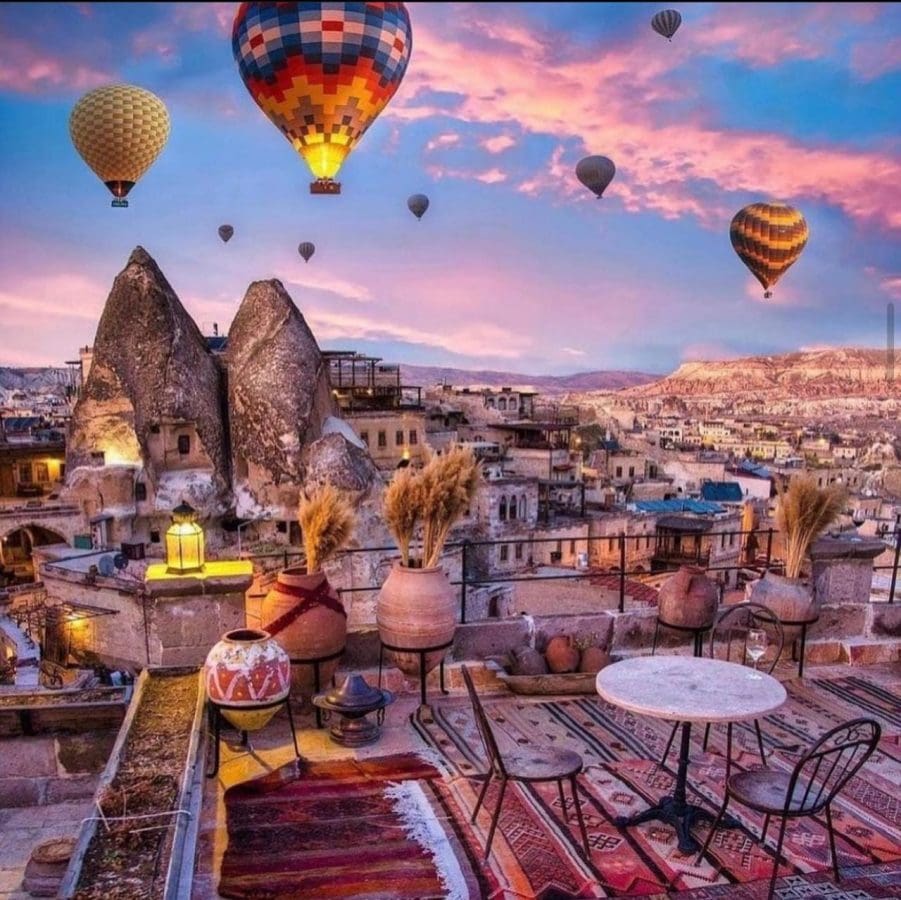We have wanted to do a series of articles on Turkiye for several months, so we
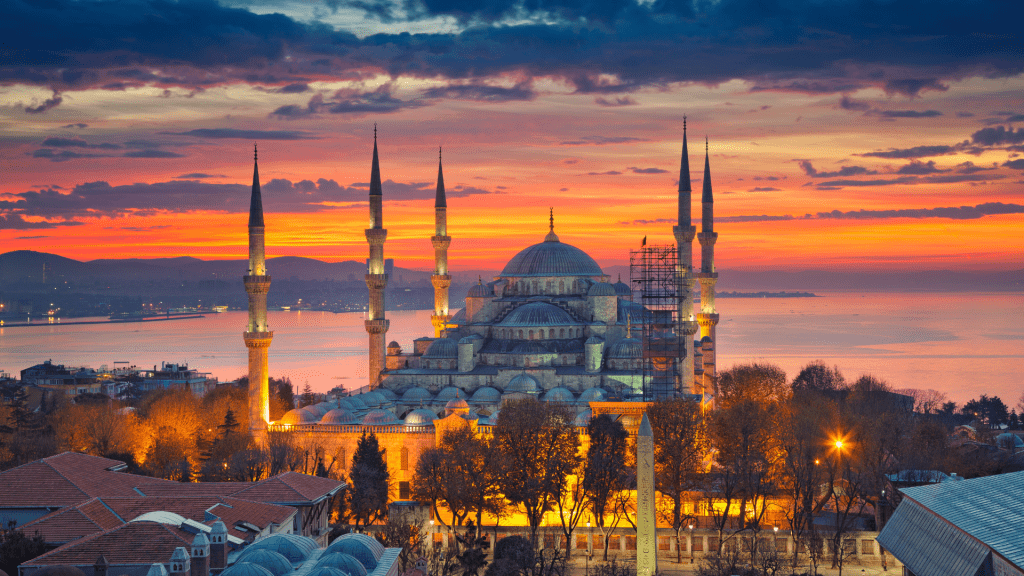
We have wanted to do a series of articles on Turkiye for several months, so we sent our roving reporter Grainne off to Turkiye on a whirlwind cultural tour.
What’s going on with the spelling of Turkiye?
Well, it’s simple in December 2021, President Erdoğan ordered the use of Türkiye to represent better Turkish culture and values, including a demand that “Made in Türkiye” be used instead of “Made in Turkey” on exported products. So, it’s called Turkiye now, not Turkey. There you go. I said it was simple.
Turkiye is a fascinating country and one that few of us probably know much about. So, in this article, I will hopefully enlighten you on some of the essential visitor locations and of culture and couture.
Our reporter Grainne flew into Istanbul for a whirlwind cultural tour of Turkiye. As you may know, Turkiye is full of ancient sites, unique beauty, and unparalleled destinations; visiting Türkiye is an unforgettable experience. With adventures waiting for you all around the country, Türkiye offers memorable experiences, individual tastes, and magical landscapes.
ISTANBUL: A THRIVING SCENE OF ARTS, DESIGN, AND CULTURE
Are you ready to explore the city where two continents meet? With one foot in Asia and the other in Europe, Istanbul, the ancient capital of the Eastern Roman Empire / Byzantine Empire and the Ottoman Empire, knows how to combine its contemporary culture with ancient traditions.
The bustling metropolis of Türkiye is a city full of charm, where the past goes hand in hand with the present, and every step brings to light a relic of times gone by.
This spectacular city has absorbed the best of both worlds, where it sits at the crossroads of two continents. With its beautiful historic landmarks, outstanding cuisine, vibrant nightlife, festivals of art and music, a celebration of faith, labyrinths of marketplaces and shopping arcades, the beating heart of Istanbul and the soul of Bosporus is a traveller’s dream.
Istanbul’s funky, contemporary side stages impressive artworks and performances. The best place to see some major works of contemporary Turkish art is the Istanbul Modern (https://www.Istanbulmodern.org/en) Before you travel, check their website for listings. In addition to museums like Topkapı Palace, Dolmabahçe Palace and Istanbul Archaeological Museums, there are also some private initiatives that have been showcasing fashion, jewellery, and perfumery in this must-visit city.
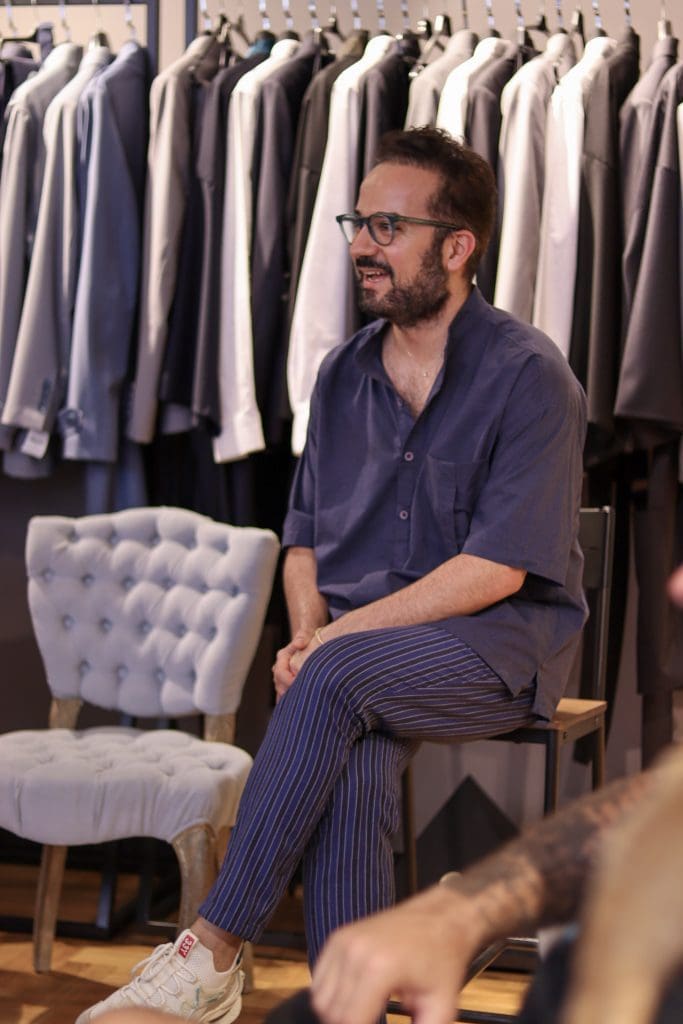
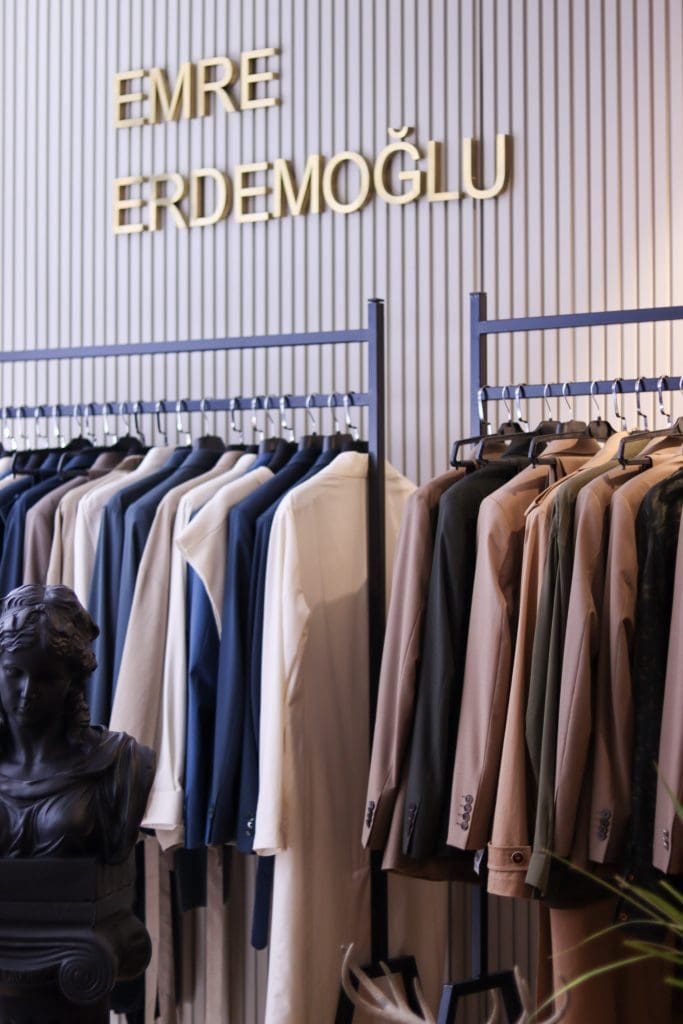 The major art galleries are based in Nişantaşı, is a residential quarter in the Şişli district on the European side of Istanbul. They showcase cutting-edge modern and contemporary artworks by local and international artists. There are also a few galleries offering artworks from classical Turkish painters and numerous auction houses. Nişantaşı is also home to some elegant designer boutiques, glamorous international stores, and upscale restaurants. So, it’s where to spend a stylish afternoon or a luxurious evening.
The major art galleries are based in Nişantaşı, is a residential quarter in the Şişli district on the European side of Istanbul. They showcase cutting-edge modern and contemporary artworks by local and international artists. There are also a few galleries offering artworks from classical Turkish painters and numerous auction houses. Nişantaşı is also home to some elegant designer boutiques, glamorous international stores, and upscale restaurants. So, it’s where to spend a stylish afternoon or a luxurious evening.
In Karaköy, Galata and Çukurcuma neighbourhoods, near the brand-new Galataport facility, you will find some hip galleries and contemporary art spaces that promote the new generation of Turkish artists. They represent artists who are at the early stages of their careers, across a wide array of mediums, from painting to photography and sculpture. Full of antique shops, souvenir shops, and street food venues, these quarters are perfect for exploring the Turkish contemporary art scene as you wander the backstreets.
Istanbul, Türkiye’s capital of culture and fashion, is also a shopping paradise and offers its guests shopping opportunities like nowhere else in the world.
It presents a myriad of great destinations and hubs to go shopping with its century-old bazaars, elegant shopping districts, exclusive fashion boutiques and modern shopping malls. While significant tourist attractions like the Grand and Spice Bazaars combine historical sightseeing with a unique shopping experience, they also stand out as the perfect spots to buy an endless variety of products to suit all tastes. But remember you have a baggage allowance!
Check out Emre Erdemoglu
Now if you want upmarket, then try the elegant and artsy shopping districts such as Nişantaşı, Beyoğlu, Bebek, and Bağdat Street. These streets are filled with significant luxury designer stores, exclusive fashion boutiques, and art galleries, along with well-known international and local high-class brands.
Moreover, modern shopping malls, including Zorlu Center or the likes of the rejuvenated Galataport area, welcome visitors with a mix of high fashion outlets from local designers and exclusive international fashion, accessories, and jewellery brands.
Galataport
Located at the city’s heart, Galataport Istanbul is a major waterfront development project covering 1.2 kilometres of coastline on the Bosporus. The project has brought to life an area previously closed to visitors for almost 200 years.
The Galataport, as it is known, is a complex of museums, shops, restaurants, and breweries on the picturesque banks of the funky Karaköy district, it stands out as a mixed-use destination with various activities and functions appealing to the cruise passengers, crew, tourists, and locals alike.
The Galataport, the new landmark of the Bosporus’ shore, where modern travellers come to see not only Hagia Sophia Grand Mosque or Sultanahmet (Blue Mosque) but also experience a new neighbourhood dedicated to culture, art, design, new-generation shopping, and gastronomy.
While in Galataport don’t miss the opportunity to visit Atelier Rebul. The story begins in 1895. Jean Cesar Reboul, a young French pharmacist, travelled through Istanbul on his way to Trabzon. A town in northeastern Turkiye to visit his father, who worked as an engineer to build the highway from Hopa to Trabzon. With its unique blend of old-world mysticism and modern commerce, Istanbul immediately captured his imagination. The entrepreneur in him woke up, and he found the perfect place, on Rue de Pera in Beyoğlu, to open one of Turkey’s first pharmacies.
Atelier Rebul believes that there is an essential link between nature and pharmacology. As a brand specialising in pharmacology, they know a lot about herbal extracts. They believe that the answer to most health problems lies in nature. With their pharmacy roots, they know which plant will work best for the problem they’re trying to solve.
They take the traditional knowledge and methods of mortar and pestle that are an indispensable part of pharmacy and use it to create safe and healthy formulas, creating formulas with a very natural content.
Atelier Rebul follows the philosophy of 100% trust & 100% transparency. Since 1895 they have more than 1,500,000 formulas. They use traditional knowledge and methods about herbal content that have been created for over 120 years. https://www.atelierrebul.com.tr/en/home/
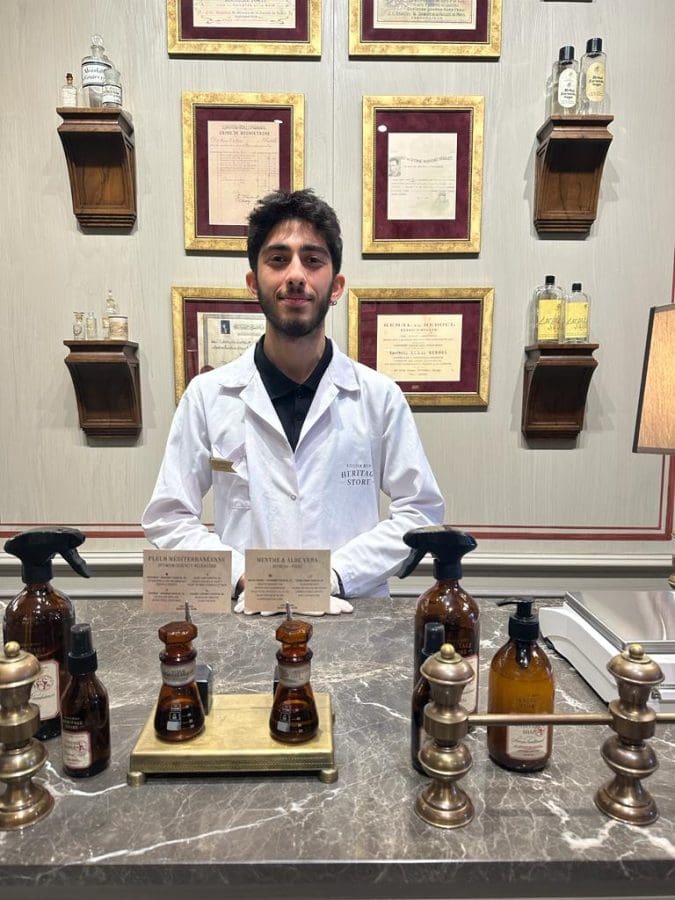
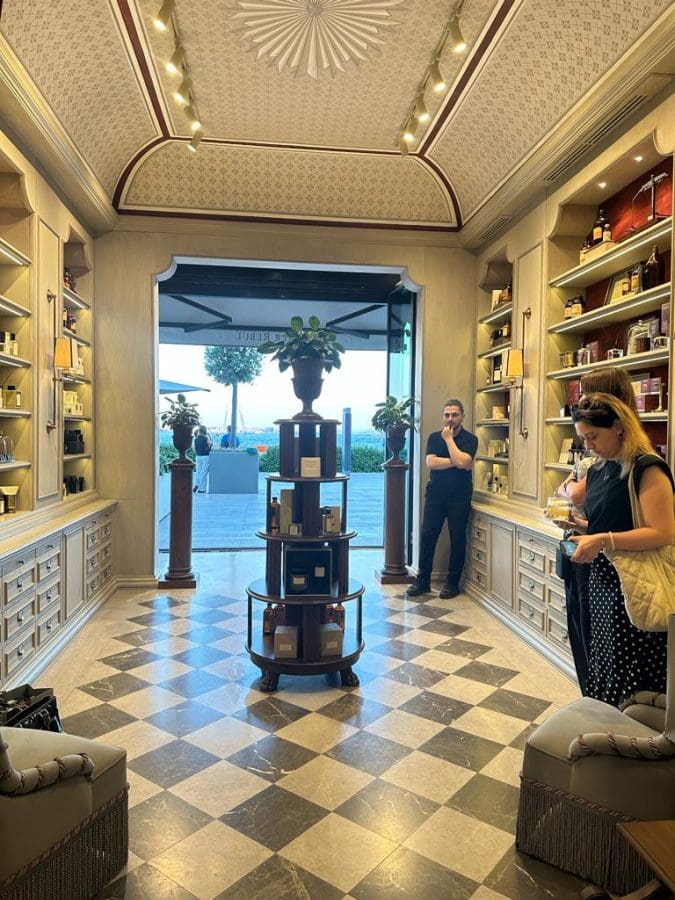
Galataport is also the world’s first underground cruise terminal with a hatch system that separates the cruise passengers’ customs and security (ISPS) areas, keeping the promenade open to the public. Galataport features numerous domestic and international brands that offer a wide selection of Turkish and world cuisines. Besides, it houses the finest works of modern art in Türkiye with the Istanbul Museum of Modern Art and Mimar Sinan University, Istanbul Museum of Painting and Sculpture inside its premises.
Great attention has been paid to the heritage here; where the architecture has been designed according to a neighbourhood concept that harmonises with the historical fabric of the area and alternative transport options.
Historical Peninsula
The historic areas of Istanbul were placed on the UNESCO World Heritage List in 1985, they offer fine examples of Eastern Roman/Byzantine and Ottoman art and architecture. Encompassing the area surrounded by Haliç (the Golden Horn) in the north, Bosporus in the east and the Marmara Sea in the south, the Historical Peninsula is home to Hippodrome, Hagia Sophia, Sultanahmet (Blue) Mosque, Hagia Irene, Little Hagia Sophia Mosque, and Topkapı Palace, Istanbul City Walls. This is a must-see part of Istanbul.
Hippodrome
Constructed under the reign of Eastern Roman Emperor Septimus Severus c. CE. 200, Hippodrome was the very centre of civil activities of the ancient city.
The Hippodrome mainly functioned as a sports centre, where the chariot races and circuses served as a diversion for the people of the city. However, during the Ottoman period, the site of the arena became a public square. In the central axis of the arena were ancient monuments such as the Egyptian obelisk – brought from Egypt in the late 4th century. Another monument is the Serpentine Column in the shape of three intertwined bronze serpents; this was the base of a trophy that once stood in the Temple of Apollo at Delphi, the famed oracle centre of antiquity. Later monument in the Hippodrome is the German Fountain, a domed structure presented to the Ottoman Empire by Kaiser Wilhelm II in 1895.
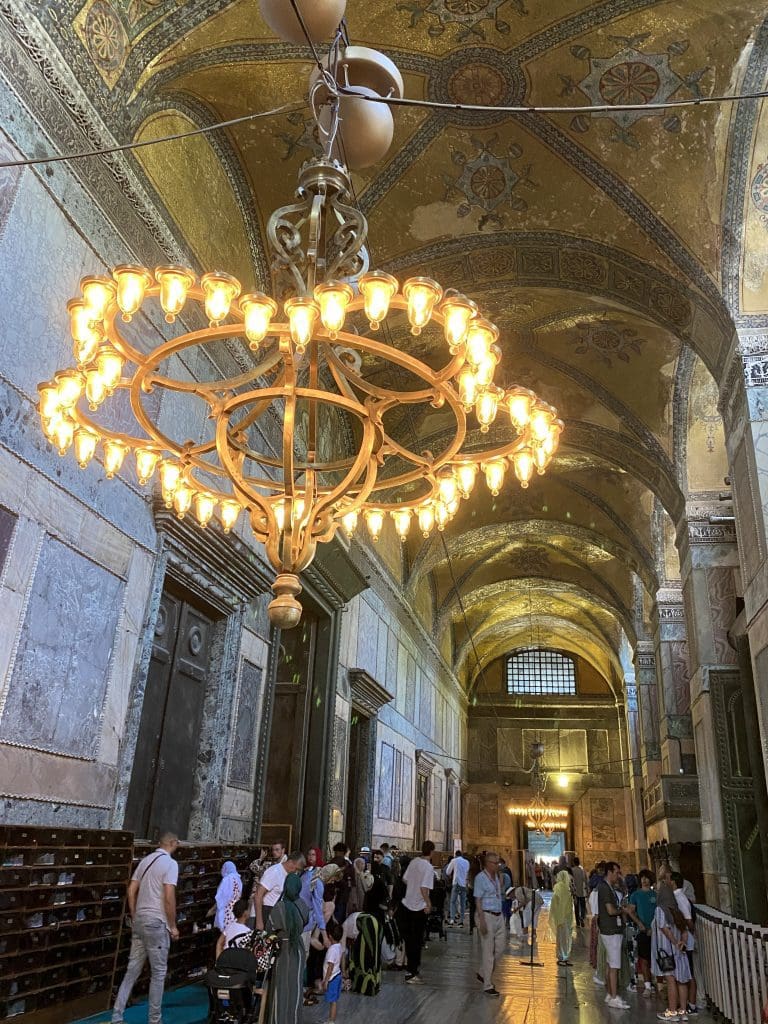 Hagia Sophia
Hagia Sophia
The 6th-century Hagia Sophia building is easily recognisable with its vast dome. Emperor Justinian built it on the Eastern Roman Empire’s acropolis site (532-537 CE). Then known as the Church of Holy Wisdom, Hagia Sophia is a remarkable testament to the ingenuity of Eastern Roman architects.
A new chapter in its history began when Ottoman Sultan Mehmed II converted it into a mosque and painted over the golden mosaics and frescoes with Islamic motifs and patterns. Some of them have since been uncovered again and have survived for centuries under layers of plaster. The Sultan also added massive panes of beautifully crafted calligraphy. Besides, four minarets were also added to the vast, domed structure at different times.
At the turn of the 20th century, the mosque was converted into a museum at the behest of Mustafa Kemal Atatürk, the founder of the Turkish Republic, in 1935 and remained so for many years. And in 2020, it was announced as a mosque once again.
Dominating Istanbul’s skyline, this quaint edifice has been expanded and restored several times throughout the centuries. It is an impressive expression of religious faith and one of the greatest architectural wonders in the world. It’s an incredible structure that has stood the test of time, mainly because its dome was the largest feat of engineering in the world.
One can admire the spectacle of the dome of Hagia Sophia. The central dome is 55.6 m above the floor and is supported by four triangular segments of a spherical surface. Hagia Sophia is one of the earliest examples of using the ‘pendentive’ in architecture. Yes, it is vast and stunning on the outside, but the magic kicks in when you step inside. Adorned with winged cherubs, the central dome is also an architectural feat from the inside.
Ancient frescoes and gilded mosaics of the Virgin Mary and Christ, restored after the mosque was converted into a museum, also sit beneath the magnificent dome alongside 19th-century leather medallions. Forty separate windows at the dome’s base open the depth perspective, allowing the optical heaviness to dissolve into a floating light space. Golden mosaics allow the light to shimmer and direct it onto multi-coloured polished panelling and marble columns that collect and reflect it.
Hagia Sophia was inscribed on the UNESCO World Heritage List in 1985 under Historic Areas of Istanbul. One of the oldest holy shrines in the world, the awe-inspiring edifice today serves as a mosque to the common culture of humankind. As one of Istanbul’s most famous and iconic landmarks, it is an ode to the Eastern Roman and Ottoman taste for art and architecture.
Grand Bazaar
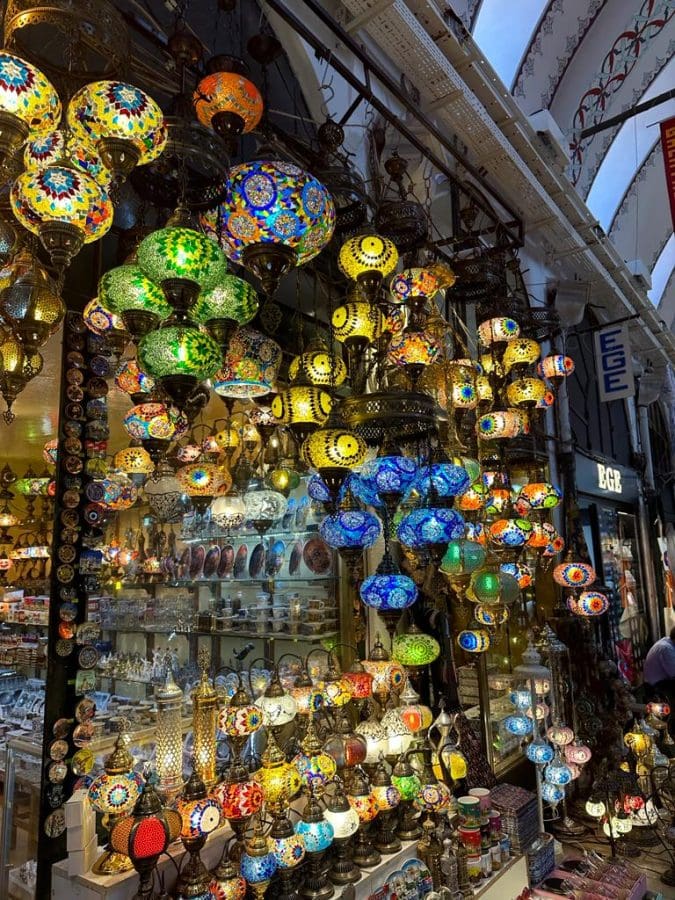
Known as Kapalıçarşı by the locals, Grand Bazaar is one of the world’s greatest shopping destinations. Spanning 30,700 square metres and housing around 4,000 shops located in 64 streets, it is the largest market in the world.
is one of the oldest and largest covered markets in the world. Its history dates back over 500 years, making it a true cultural and historical gem.
The Grand Bazaar’s sheer size and complexity can be overwhelming at first, but it’s a delight for all the senses once you step inside. As you wander through its labyrinthine alleys and passages, you’ll be surrounded by a rich tapestry of history. The market was constructed in the 15th century during the reign of Sultan Mehmed the Conqueror, and it has been an essential part of Istanbul’s social and economic life ever since.
Bargaining Culture:
Prepare yourself for the art of bargaining. Haggling is an integral part of the shopping experience at the Grand Bazaar. Vendors expect customers to negotiate the prices, so don’t be shy to engage in friendly banter while trying to strike a deal.
Turkish Delights:
Amidst your shopping adventures, you’ll encounter small stalls selling an array of Turkish delights, exotic spices, and aromatic teas. Take the opportunity to savour the flavours and aromas of the local cuisine. The Grand Bazaar is also surrounded by charming cafes where you can relax and enjoy some traditional Turkish coffee.
Tips for Visitors:
When visiting the Grand Bazaar, it’s essential to be mindful of your belongings as it can get crowded, especially during peak tourist seasons. Wear comfortable shoes, as you’ll be doing a lot of walking, and consider setting aside a few hours to explore its many nooks and crannies.
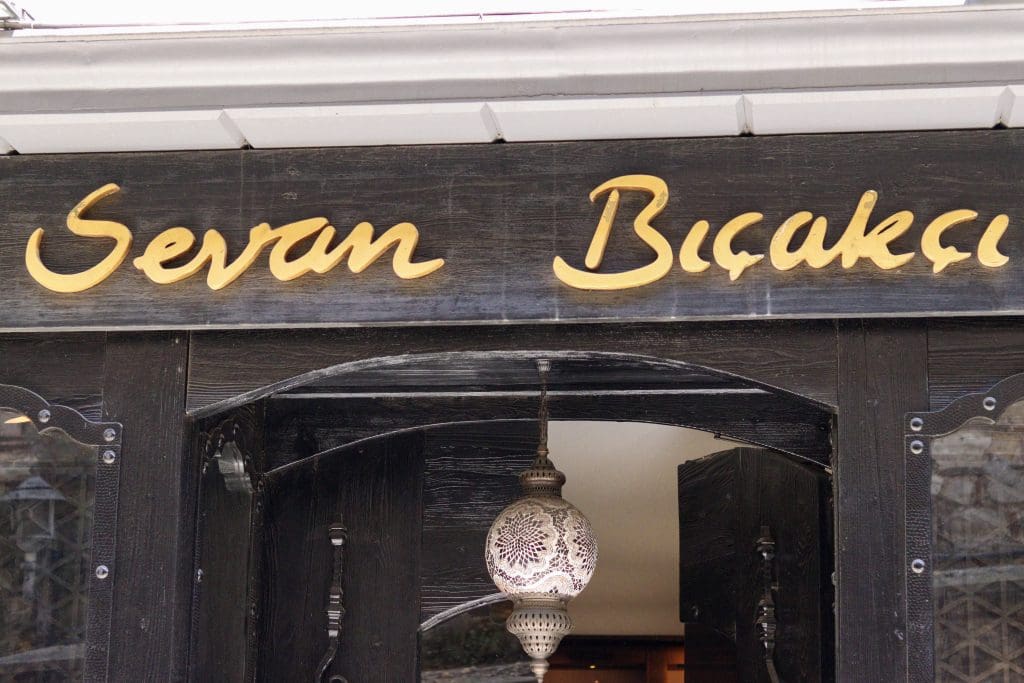 Sevan Bıçakçı www.sevanbicakci.com
Sevan Bıçakçı www.sevanbicakci.com
Sevan Bıçakçı grew up in what you could call one of the classic workshops of the Grand Bazaar. His curiosity and energy knew no bounds, leading to many adventures and formative experiences. And every day, he still hears the sounds from the streets he walked as a child. Sevan listened to the birds and trees and the delightful sounds of the many places of worship that Istanbul offers.
He crossed the Bosporus by ferry on a daily basis and soaked up the atmosphere as his imagination expanded by staring at the domes of the Hagia Sophia and the magnificence of the rich history that surrounded him.
Sevan was only a child (12) when he started his apprenticeship, which lasted for 10 years. Now Seven is an internationally renowned jeweller with some of his pieces commanding 7 figure amounts. His skill set is unparalleled today, and he creates some of the most impressive pieces of jewellery you are likely to see. But what makes his pieces unique is not only the stories that inspired him but the craftsmanship he has entrusted to his master craftsmen, the collaborations he’s made with artists, sculptors, glassworkers, or ceramic masters outside the jewellery world, and the curiosity to turn precious stones into even more precious pieces.
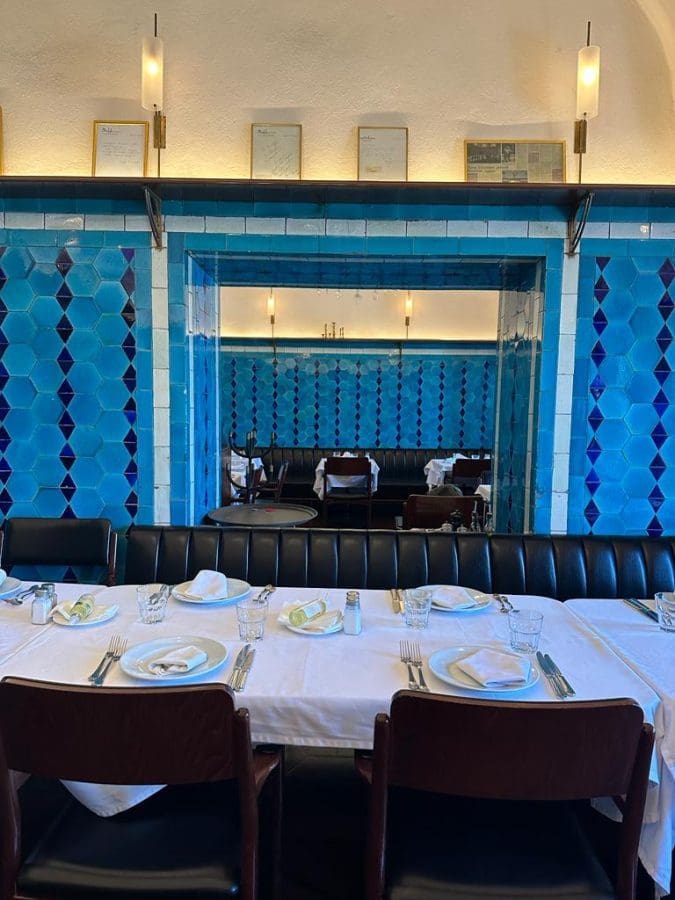
Considering the heat in Turkiye at this time of year, I decided to take a break and visit the famous Pandeli Restaurant in the Spice Bazaar.
Pandeli Restaurant is an iconic dining establishment in Istanbul. It’s found in up a set of stairs just as you enter the Spice Bazaar, and it retains a significant place in the city’s culinary history Pandeli is noted for its traditional Ottoman cuisine and unique atmosphere. The restaurant’s history stretches back to the 1900s when it was founded by an Armenian immigrant named Pandeli. Over the years, the eatery has become a beloved culinary institution serving authentic Ottoman cuisine.
One of the highlights of dining at Pandeli is its timeless ambience. The restaurant’s interior maintains its classic Ottoman-era charm, with vintage decor and elegant furnishings. The atmosphere exudes a sense of nostalgia, transporting visitors back to a bygone era. Apart from its delectable cuisine and historical setting, Pandeli also offers stunning views of the Bosphorus Strait and the iconic landmarks of Istanbul.
Signature Dishes:
Pandeli is known for signature dishes include the Sultan’s Delight (Hünkar Beğendi), a savoury lamb stew served over a bed of creamy eggplant puree, and various seafood specialities prepared in the Ottoman style.
http://www.pandeli.com.tr/
lık Pazarı Kapısı Sokagı 1/2,
Mısır Carsısı İci Eminönü,
Istanbul 34110 Türkiye

Spice Bazaar
The Spice Bazaar is in Istanbul’s Eminönü district near the Galata Bridge. This place will give your senses a roller-coaster ride, bar none. In its heyday in the 17th century, this L-shaped, richly decorated bazaar was the last stop for caravans travelling on the Silk Road from China, India, and the East.
The bazaar is much smaller today and now focuses on spices and other foodstuffs. The sights and smells of this Istanbul market transport everyone to a dreamland. With less than a hundred vendors, it’s not nearly as busy as the Grand Bazaar, but there’s still plenty to buy, especially if you want to be able to recreate the authentic food and drink of your Istanbul trip when you get back home.
So, what makes the Spice Bazaar so attractive?
The Spice Bazaar is both historically and aesthetically appealing. It may not be easy to walk through the bazaar and not buy anything, although the natural soaps hanging from the ceilings of the stalls can be a real temptation. Wandering through centuries of architecture and strolling under the beautiful, vaulted ceilings, it’s hard to remember that this is a market. But a market like no other where the sights and fragrances envelop your senses and remind you of years gone by. The construction of the Spice Bazaar began in 1597, during the reign of Ottoman Sultan Mehmed III. It was completed in 1660, and it is an architectural masterpiece with a unique design. As the name suggests, the Spice Bazaar is renowned for its extensive selection of spices, herbs, and traditional Turkish foods. You can also find a wide array of goods such as exotic spices, nuts, dried fruits, Turkish delight (Lokum), tea, coffee, dried herbs, saffron, and more. One product that stands out for its bright colours and variety is the sweet delicacy Lokum (Turkish delight). It’s not quite like the chocolate bar you may have had as a child. The original sweet has a sticky consistency, and the texture is solid but squidgy. You can enjoy these sweet treats during teatime or the next time you are invited to have a Turkish coffee. Turkish delight is created by mixing citric acid, starch, and sugar. Various flavours are added, and after cooking, it is laid out on a cold surface to cool before its cut and dusted with fine icing sugar.
Following my visit to the Spice Bazar, I was off to continue my cultural tour, and I visited Nişantaşı.
Located in the Şişli district of Istanbul’s European side, Nişantaşı is a neighbourhood encompassing parts of the Meşrutiyet and Teşvikiye neighbourhoods situated around Vali Konağı (Governor’s Mansion).
The neighbourhood, which is a shopping haven, is known for hosting stores of world-famous luxurious brands, cafés, and entertainment venues. The residential area attracts Istanbul’s fashionable and artistic crowd with its many boutiques selling famous international and local brands and luxury clothing stores with magnificent window displays. This is a great place to enjoy shopping outdoors and the perfect destination for charming cafés and fancy restaurants.
Head to Abdi İpekçi Street for the hippest eating establishments serving both Turkish and world cuisines. Don’t be surprised if you spot many celebrities here!
Nişantaşı is also famous for its entertainment venues, such as nightclubs and bars, in addition to its art galleries, where international and Turkish artists exhibit their work.
When visiting the Nişantaşı area, it’s hard not to be enticed into some of the amazing designer outlets that have their workshops and studios in this vibrant area.
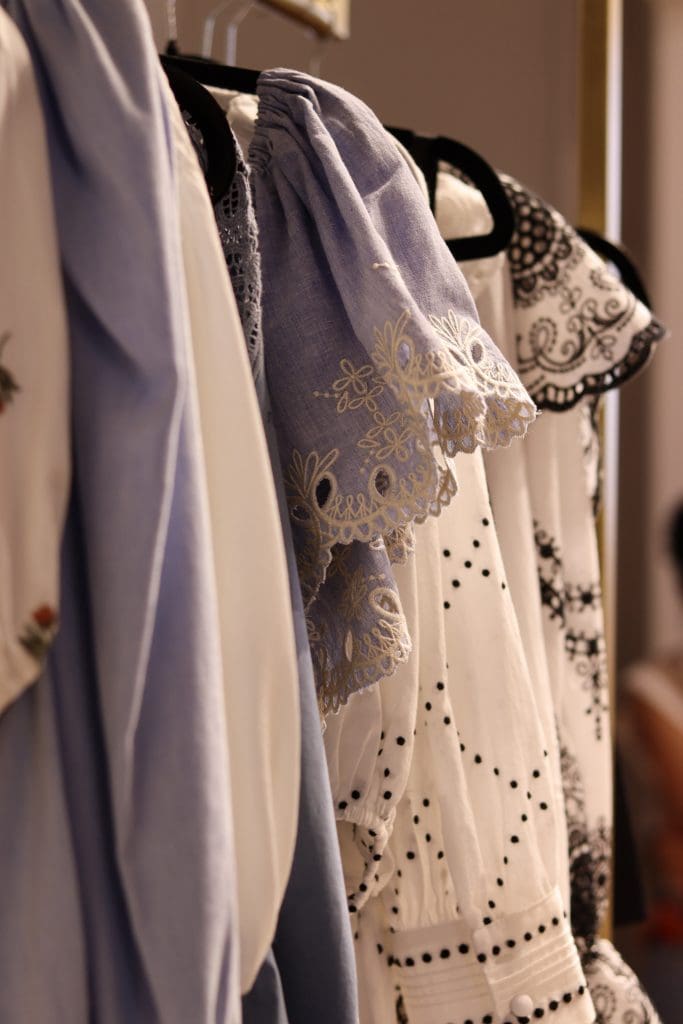
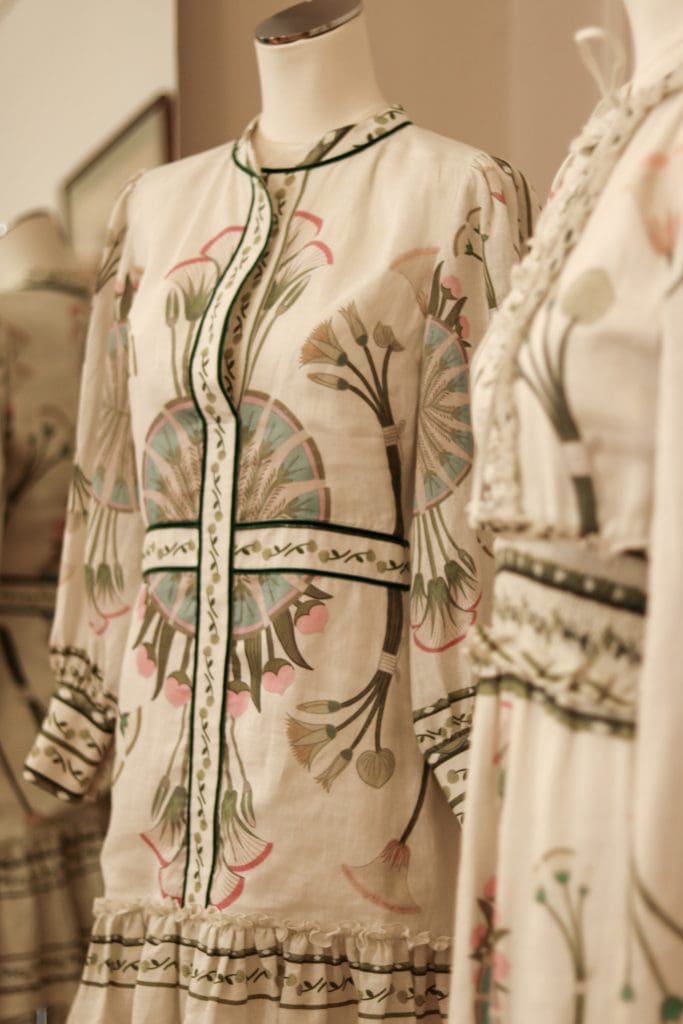 Our first stop was the designer GUL AGIS, Gul is the Creative Director and Founder of the design label Lug Von Siga. After completing her first major in English Language and literature, Gul Agis studied fashion design at the Istituto Marangoni, and she completed her fashion design master’s degree at the Politecnico Di Design University in Milan. After her graduation, Gul has been working for, and consulting many fashion houses as well as companies both in Milan and Istanbul. She has recently created her own ready-to-wear brand with the acronym of her name, as Lug Von Siga.
Our first stop was the designer GUL AGIS, Gul is the Creative Director and Founder of the design label Lug Von Siga. After completing her first major in English Language and literature, Gul Agis studied fashion design at the Istituto Marangoni, and she completed her fashion design master’s degree at the Politecnico Di Design University in Milan. After her graduation, Gul has been working for, and consulting many fashion houses as well as companies both in Milan and Istanbul. She has recently created her own ready-to-wear brand with the acronym of her name, as Lug Von Siga.
Being respectful to her own heritage and culture, her love for prints, fabric manipulation and embroideries made LVS a highly recognised and respected brand within the global platform. Gul Agis loves collaborating with many creative artists from different disciplines and all over the world. She is without doubt a force in the fashion world and makes many elegant outfits. Lug Von Siga strives to be a timeless brand by proposing versatile and elegant pieces with an accessible price point. In Lug Von Siga collections, essentials are interpreted through comfortable yet feminine forms. Separates aim to appeal to a dynamic woman who likes to mix and match and have fun with her wardrobe.
Gul Agis always links her collections to different stories, and there is always a mix of sportswear-inspired, casual as well as elegant pieces enriched with embellishments, trims and /or prints. Patterns and embroideries that are pivotal to every collection are exclusively designed by Gul Agis. Every collection has its own comforting story and smooth approach.
Istanbul Cuisine
Nurtured and shaped by deep-rooted Anatolian heritage, Turkish cuisine is a defining element of Turkish culture. Every dish on Turkish tables has a story behind it, carrying a vast cultural accumulation to modern times. Türkiye has a massive gastronomic heritage thanks to the multicultural character of the Ottoman and Eastern Roman/Byzantine Empires, as well as the rich and varied geographic characteristics and culinary traditions of each and every region in the country. From robustly flavoured kebabs to vegan specialities cooked in olive oil, traditional Turkish cuisine offers a variety of savours. And Istanbul is its tasting room.
The selection of the MICHELIN Guide Istanbul 2023 reflects the diversity, culinary traditions and openness of the local culinary landscape. With 53 restaurants in the selection, Istanbul’s culinary scene offers unique experiences for international gourmets. The selection of the MICHELIN Guide Istanbul 2023 at a glance: 1 restaurant with Two MICHELIN Stars, 4 restaurants with One MICHELIN Star, 1 restaurant with a MICHELIN Green Star, 10 Bib Gourmand restaurants, 38 recommended restaurants.
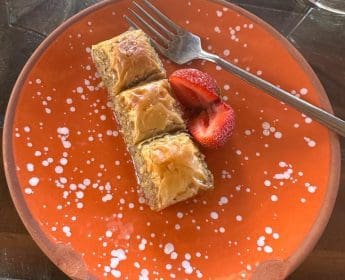
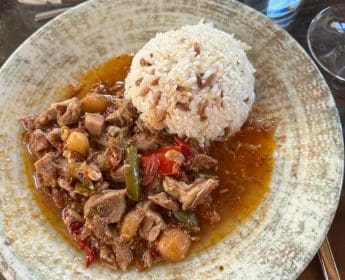
CAPPADOCIA
A moonscape region carved by nature and humans, Cappadocia is most famous for its unique geological features and layers of history. The region is created by the erosion of the soft layers formed by the lava and ashes sprayed by the volcanic mountains of Erciyes, Hasandağ, and Güllüdağ and has been shaped by rain, wind, and ice for millions of years.
In Cappadocia’s magical landscape of fairy chimneys, in the ancient village of Urgup, lies a unique cave hotel carved into a mountain cliff, the Yunak Evleri. This hotel includes 10 cave houses, a total 136 rooms dating back to the 5th and 6th centuries and a 19th-century Greek Mansion.
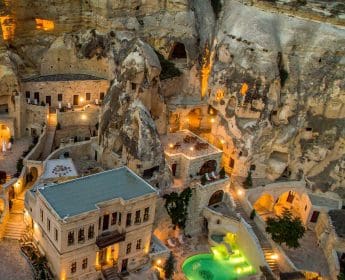 Yunak Evleri is an inspiring hotel – an ideal base for exploring Cappadocia’s elaborate underground cities, hidden cavernous churches and enchanting rock terrain.
Yunak Evleri is an inspiring hotel – an ideal base for exploring Cappadocia’s elaborate underground cities, hidden cavernous churches and enchanting rock terrain.
This beautiful Hotel boasts 10 cave houses with a total of 120 private cave rooms dating back to the 5th and 6th centuries and crowned with a 19th-century Greek Mansion. The name of the neighbourhood, “YUNAK” comes from the old days when women used to do all their washing and socialising by the fountain at the village square. Being by the fountain and at the Yunak was the centre of daily life. A labyrinth of narrow passageways and curved stone stairways leads to unique rooms tastefully decorated in a warm traditional style. If you visit the region, this is a superb place to stay. These exceptional cave houses are renovated and decorated with care and in their own distinct style, strictly preserving the local character. The decor is elegant and personalised, with beautiful hand-crafted furnishings and antiques. All rooms have private patios overlooking the Turkish Mesa. With 120 rooms, Yunak Evleri is small enough to be intimate yet large enough to offer you privacy.
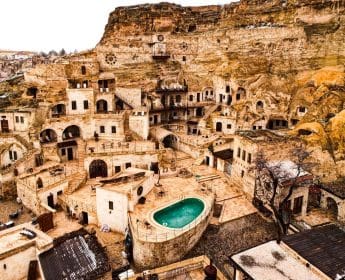
At the foot of the cliff stands the hotel’s main lobby. Housed in a 19th-century Greek mansion, the main building exudes a kind of sophisticated charm. Within the stone building, cosy meeting rooms provide a soothing atmosphere for lounging in the evening.
Alongside a small business centre with an Internet connection, the music room has a wide variety of CDs you can borrow, and the TV room is decked out in plush Turkish cushions with a view of the surrounding cliffs. A DVD room on the second floor is decorated with local handmade pottery accessories, candles, and a lovely furnace.
Yunak Evleri also has 2 outdoor swimming pools with fine views across to the fairy chimneys & rock formations. There is also a beautiful spa.
Evenings are characterised by sunset gatherings on soft upholstered Turkish pillows warmed by an outdoor fireplace. Candlelight dining is offered on the adjacent rooftop terrace. We serve local homemade foods for dinner and an open-buffet breakfast.
Yunak Evleri (www.y unak.com) opened its doors to its guests in 2000 and since then has hosted around 200,000 travellers from all regions of the world.
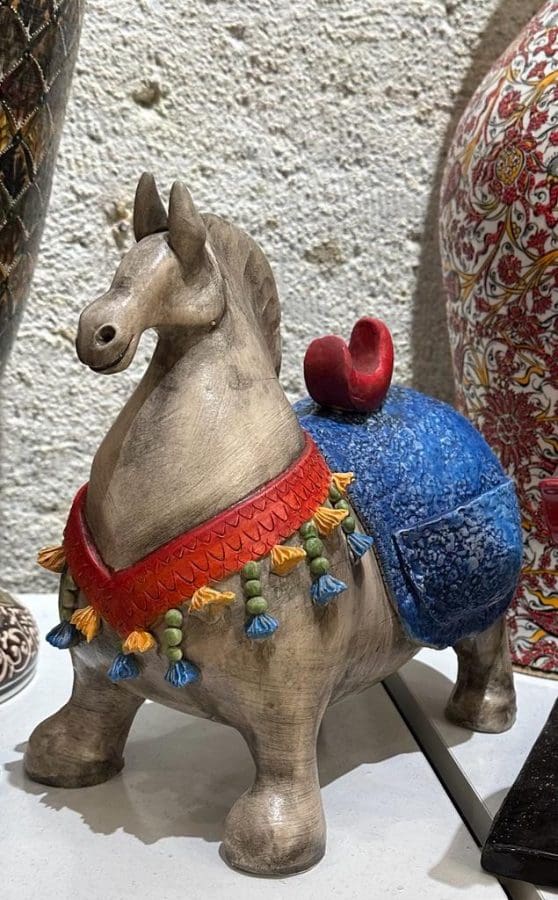
Whilst in The Cappadocia region give the Avanos and Pottery Workshop Experience a visit.
Tours are on most days and can be booked at www.avanospotteryworkshop.com
The town of Avanos is famous for its tradition of pottery-making, which has been alive since the Hittites in the Cappadocia region. Some of today’s techniques date back to 2000 BCE and specifically to Hittite times. Locals take clay from the nearby Kızılırmak River (Red River) and turn it into perfectly formed pottery and ceramic pieces such as wine jugs. If you want to try it, some ateliers offer a chance to take up your position before the wheel. What happens next is up to the skills of your hands and the vividness of your imagination. Master potters standing nearby will lend you their support and maybe give you a few pointers.
THIS IS A MUST FOR ALL TRAVELLERS

The awe-inspiring panorama of Cappadocia is not complete with the colourful hot air balloons flying above the rock formations.
The balloon rides in Cappadocia start just before sunrise, which means an early start, but what an experience you will have. The enthralling morning flights have been attracting more and more travellers worldwide. The balloons rise to about 500 metres high, and they depart from the area around Göreme early in the morning and usually finish with top a bubbly champagne celebration.
Then, you may embrace an organic-friendly Turkish breakfast with a view of Fairy Chimneys. Visit: www.airkapadokya.com for more information.
Cappadocia has many historic places to visit.
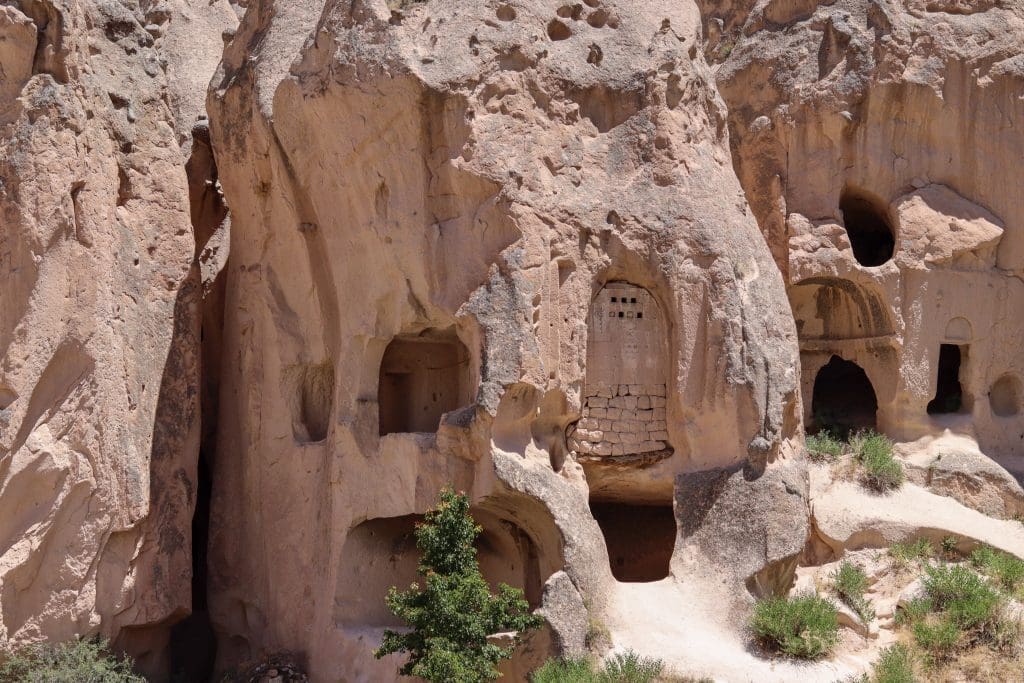 Paşabağ Valley
Paşabağ Valley
Paşabağı, also known as Monk’s Vineyard, is situated about 1 kilometre off the Göreme-Avanos road to Zelve. There are several fairy chimneys with multiple stems and caps, some unique chapels and living quarters in this magic land.
Zelve Valley
Consisting of three valleys, Zelve ranks first in terms of the density of fairy chimneys. If you want to examine the beauties of nature here, you should start trekking early in the morning. The famous churches in the valley are Balıklı and Üzümlü, illustrating the ancient monastic life.
Devrent Valley
If you want to leave Zelve and go to Ürgüp, your path will pass through Devrent. Devrent is home to the youngest fairy chimneys in the region. The fairy chimney in the form of a camel has become the symbol of Devrent.
Göreme Open Air Museum
Listed as a UNESCO World Heritage site in 1985, Göreme is thought to have been used as a necropolis by the inhabitants of Venessa (Avanos) during the Roman times. It was a site of monastery life between the 4th and 13th centuries hence it is teeming with with churches carved into soft rocks
Karanlık – Tokalı Churches
Two of the most essential structures of the Göreme Open Air Museum are the Dark (Karanlık) Church and Tokalı (Buckled) Church. Dark (Karanlık) Church, dating back to the end of the 11th century and the beginning of the 12th century.
Cappadocia Cuisine
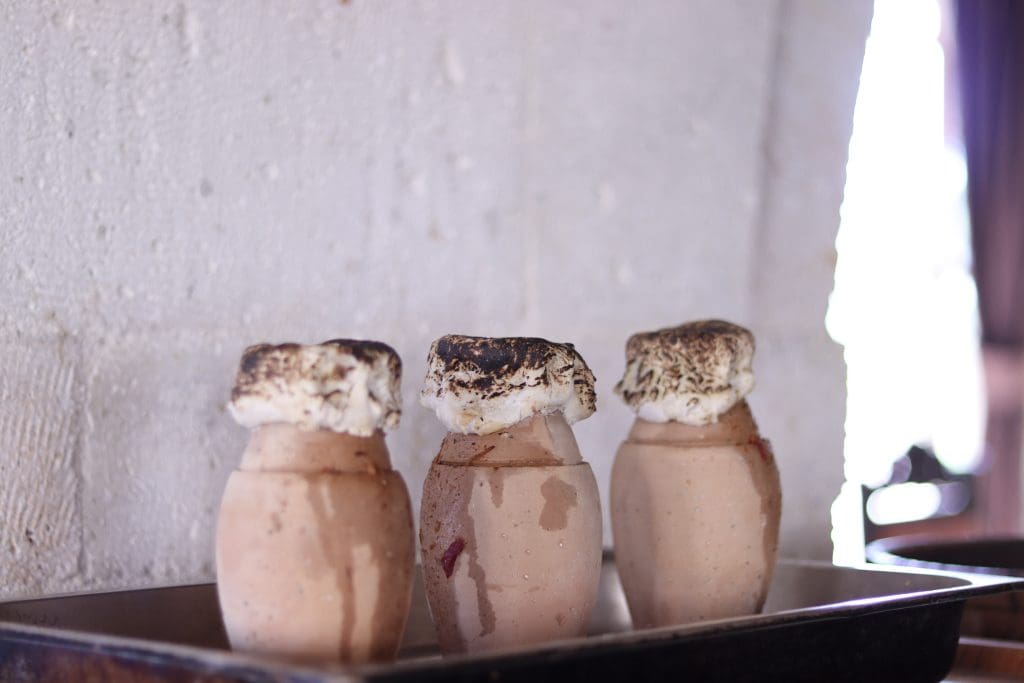
Cappadocia has a mountain of places to visit and things to do so expending all that energy requires food, and in this region, one is spoilt for choice, as anywhere in Türkiye.
From the sumptuous and overwhelming typical Turkish breakfast to the wide varieties of delicious local cuisines, various tastes will leave you spellbound.
One unique dish to Cappadocia is the clay pot kebab (testi kebabı). In traditional earthen ovens, meat, vegetables, and lentils are slow-cooked in a sealed clay pot. When the pot is broken, the smoky aroma and flavour that lie within burst out and fill one with sublime satisfaction.
I can highly recommend Revithia Restaurant, located at Kayakapı Mahallesi, Davut Ağa Sokak No:1, Ürgüp, Turkiye
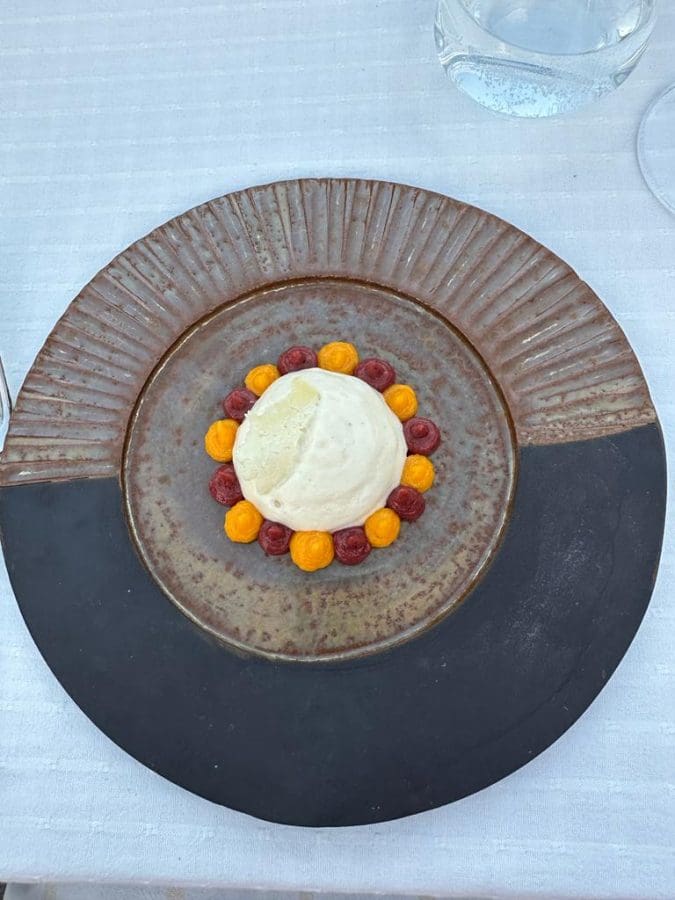
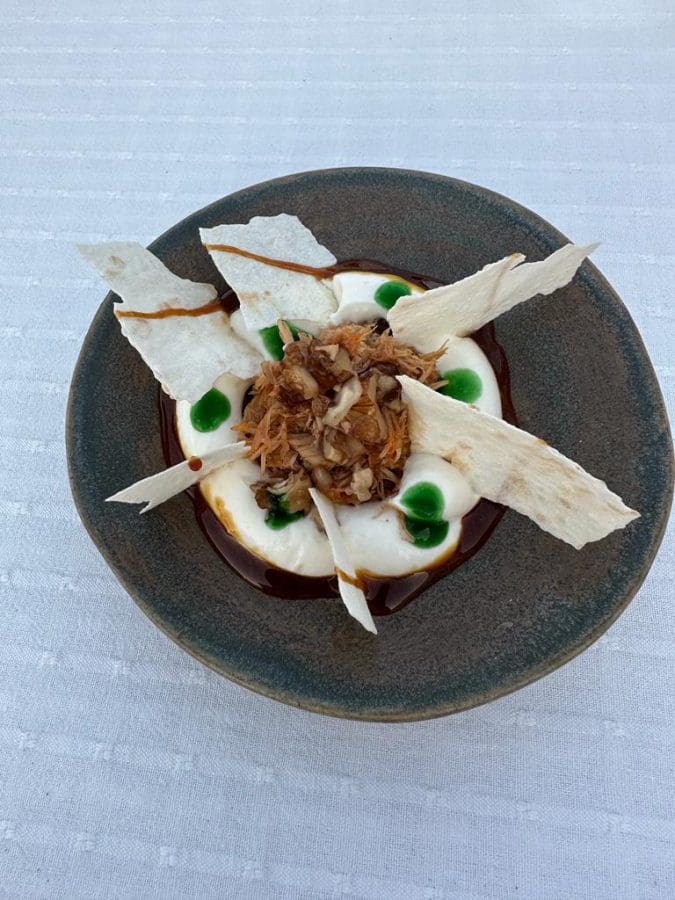

Wine
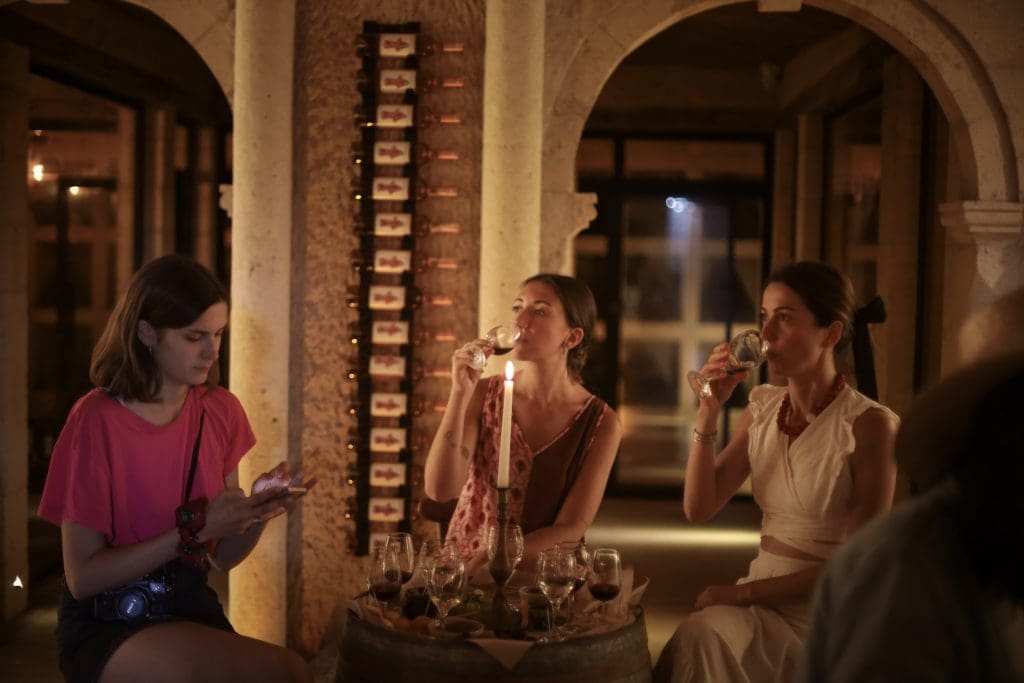 With its winemaking tradition, Cappadocia has also made a name for itself, especially with its white wine produced with local Emir grapes, which have undoubtedly become the star of these lands. The wineries in Cappadocia produce high-quality wines and are open to visitors year-round. I suggest a visit to: www.vivino.com/wineries/gulor
With its winemaking tradition, Cappadocia has also made a name for itself, especially with its white wine produced with local Emir grapes, which have undoubtedly become the star of these lands. The wineries in Cappadocia produce high-quality wines and are open to visitors year-round. I suggest a visit to: www.vivino.com/wineries/gulor
As we have seen lately, the environment plays an integral part in our lives.
So, I’m glad to see the Türkiye Sustainable Tourism Program. As a result of a signed cooperation agreement with the Global Sustainable Tourism Council (GSTC), it brings the country to the forefront of sustainable tourism. Türkiye became the first country to develop a program with the government for sustainable tourism. The Türkiye Sustainable Tourism Program rewards the actual practitioners of sustainable tourism and builds trust and credibility among visitors. Through the program, Türkiye not only fulfils obligations arising from international agreements such as the Paris Climate Agreement but also stands as an exemplar for all sectors and the world with the transformation of tourism in this direction. As of February 2023, more than 100 facilities have been awarded the Sustainable Tourism Certificate by 100% compliance with international criteria.
